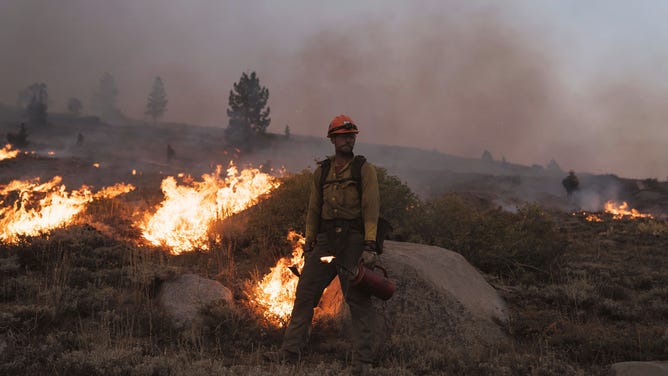What is the Haines Index?
The index ranges from 2 to 6 and was created in 1988 by Donald Haines, who was a Forest Service research meteorologist who found a simple measure of atmospheric conditions near the surface might contribute to an existing wildfire becoming a dangerous, erratic fire.

Firefighters perform a controlled burn as a preventative measure during the Caldor Fire in Kirkwood, California, U.S., on Thursday, Sept. 2, 2021.
(Eric Thayer/Bloomberg via Getty Images)
When weather conditions are ripe for wildfires, you might see some National Weather Service or fire weather forecaster discussions reference the "Haines Index" when considering the level of fire danger.
The index ranged from 2 to 6 and was created in 1988 by Donald Haines, who was a Forest Service research meteorologist, according to the U.S. Forest Service. He discovered how a simple measure of atmospheric conditions near the surface might contribute to an existing wildfire becoming a dangerous, erratic fire.
The scale uses a combination of atmospheric instability measurements and humidity. It can be calculated at three different altitude ranges, depending on where the fire in question was or could be burning.
The lowest level was considered the region between 950 millibars (about 1,800 feet above the surface) and 850 millibars (about 5,000 feet). The middle layer was between 850 millibars and 700 millibars (about 10,000 feet), while the high levels were from 700 millibars to 500 millibars (about 18,000 feet).
The atmospheric instability rating is found by taking the difference in temperature between the top and bottom of each level. The dryness component was found by taking the difference between the temperature and dew point at the 850 millibar level for both the lowest and middle altitude range and the 700 millibar level for the high-altitude range.
Each of the two measurements was given a value of 1, 2 or 3 depending on their reading, and adding the two together would get the Haines Index.

How to calculate the Haines Index
(National Wildfire Coordinating Group)
A Haines value of 2 or 3 is considered very low risk while 4 is regarded as low risk; 5 is considered moderate risk, and 6 is regarded as high danger. Note that the value only determines the risk of an existing fire becoming explosive or erratic; it does not factor in conditions that could trigger new fires.